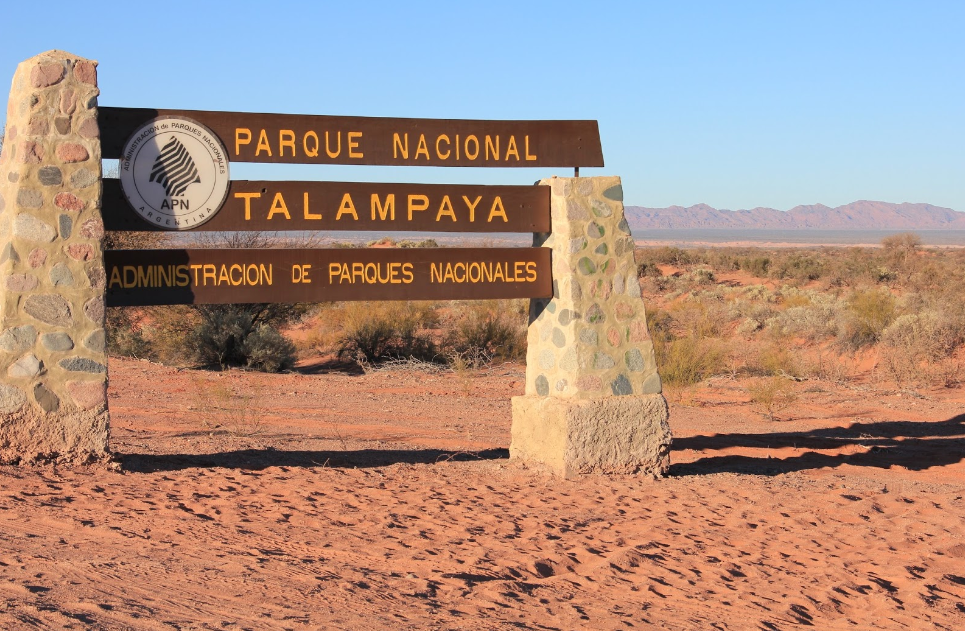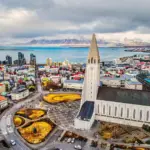
THE Talampaya National Park is a hidden treasure in Argentina, a destination that surprises with its breathtaking landscapes and rich diversity of flora and faunaThis National Park is a natural and cultural heritage site that deserves to be discovered by travelers seeking a unique and unforgettable adventure.
Main Conclusions:
- THE Talampaya National Park is a jewel of Argentina
- The park is considered a natural and cultural heritage site
- The park's landscapes are incredible and unique
- The park is home to a wide variety of flora and fauna
- A visit to the Talampaya National Park it's an unmissable adventure
Location and access to Talampaya National Park
Talampaya National Park is located in the province of La Rioja, in Argentina, about 217 km from the city of San Juan and 60 km from the city of Villa Unión.
To reach the park, there are several transportation options, including tour buses, private vans, and rental cars. The most common route is via RN 76, which connects Villa Unión and Talampaya.
Another option is to fly into the city of La Rioja and then rent a car or hire a shuttle service to the park.

Where is Talampaya National Park?
| City | Distance from Talampaya |
|---|---|
| San Juan | 217 km |
| Villa Union | 60 km |
Regardless of your chosen option, it's important to be aware that the road leading to Talampaya National Park is dirt and can be difficult to navigate in some areas. Additionally, there are no gas stations in the park, so it's important to fill up before arriving.
Natural beauty of Talampaya National Park
Talampaya National Park is a true natural treasure, full of impressive rock formations, majestic canyons and stunning landscapes. Located in the province of La Rioja, Argentina, this park offers a unique and unforgettable experience for visitors who wish to explore your beauties natural.
One of the main attractions of Talampaya National Park is its giant rock formations, dating back over 200 million years. These reddish and orange rocks create a stunning backdrop, especially at sunrise and sunset. Highlights include the Seven Colors Mountain and the Cathedral, which rise majestically above the horizon.
The park is also home to dramatic canyons, offering stunning views and hiking opportunities, such as Talampaya Canyon and Arco Iris Canyon. These impressive geological formations are the result of the action of wind and water over thousands of years.
Additionally, Talampaya National Park is home to a rich diversity of flora and fauna. Among the species found in the protected area are the guanaco (a relative of the llama), the puma, the gray fox, the Andean condor, the eagle, and several bird species. The park's flora includes over 400 species of cacti, shrubs, and trees.

The highlights of the natural beauty of Talampaya National Park can be summarized as:
| Natural attractions | Description |
|---|---|
| Rock formations | Reddish and orange rocks that create an impressive scenery. |
| Canyons | Dramatic geological formations offering stunning views and hiking opportunities. |
| Flora and Fauna | A rich diversity of species, including the guanaco, puma, gray fox, Andean condor and several bird species. |
If you're a fan of nature and adventure, Talampaya National Park is definitely a destination that should be on your travel list.

Fauna and Flora of Talampaya National Park
Talampaya National Park is a true natural treasure, with a rich diversity of fauna and flora inhabiting the protected area. Located in the province of La Rioja, Argentina, the park is renowned for its unique beauty and history fascinating.
Flora of Talampaya National Park
The flora of Talampaya National Park is characterized by a wide variety of species adapted to the region's arid conditions. The main plant species found in the park include cacti, chilcas, jarillas, and carob trees. Additionally, there are a large number of endemic plants, which are only found in the protected area.
One of the most emblematic species of Talampaya National Park is the white carob, a tree that can live up to 500 years and is considered sacred by the region's indigenous people. The white carob is one of the species most vulnerable and threatened with extinction in the park.

Fauna of Talampaya National Park
The fauna of Talampaya National Park is also very diverse, with several endemic and endangered species. Notable mammals inhabiting the park include the guanaco, gray fox, puma, wildcat, and Easter bunny.
Among the birds, the most notable are the Moray Eagle, the Burrowing Owl, the Caracara, and the Andean Condor, which is the most representative symbol of Talampaya National Park. The park is also home to several species of reptiles, including lizards, snakes, and iguanas.
To preserve and protect the rich diversity of fauna and flora in Talampaya National Park, several conservation policies are implemented, including a hunting ban and the carrying out of studies and research on the species that inhabit the protected area.
The history of Talampaya National Park
Talampaya National Park is more than just a beautiful nature destination. Its history fascinating is one of the main reasons why visitors are drawn there.
The park is believed to have been inhabited by humans for around 8,000 years. The walls of the park's rock formations are decorated with more than 4,000 cave drawings, revealing the presence of people who inhabited the region long before the arrival of European colonists.
The first explorers to arrive in Talampaya National Park were the Jesuits, who arrived in the 1600s. They founded the San Francisco Mission in El Carrizal with the aim of evangelizing the indigenous people of the region.
In the 19th century, Talampaya National Park was frequented by treasure hunters searching for gold and silver. This activity destroyed much of the park's natural resources and wreaked havoc on the rock formations.
It was only in 1975 that the park was declared a protected area, with the aim of preserving the natural beauty and the region's cultural riches. Since then, Talampaya National Park has become a major tourist destination, receiving thousands of visitors every year.

Activities and tours in Talampaya National Park
Talampaya National Park offers a variety of activities and tours that allow visitors to explore the natural beauty of the protected area. Whether you're a nature enthusiast or looking for a thrilling adventure, there's something for everyone at Talampaya National Park.
Walks
One of the best ways to explore Talampaya National Park is by hiking. There are several trails available, each with varying levels of difficulty and length. The trails lead visitors to impressive canyons, unique rock formations, and stunning views. It's recommended to bring water, sunscreen, and a hat when hiking in the park.
Bike tours
Talampaya National Park also offers tours by bike, allowing visitors to explore the area on two wheels. The routes are specially designed for bicycles and offer incredible panoramic views. tours by bike are ideal for those who want to explore the park in a unique and exciting way.
Bird watching
Talampaya National Park is home to a wide variety of birds, making it an incredible spot for birdwatching. Visitors can marvel at the beauty of species such as the peregrine falcon, the Andean condor, and the burrowing owl.
Cave exploration
Talampaya National Park is famous for its impressive caves, which offer fascinating insights into the area's geology. Visitors can take guided tours of the caves, which feature spectacular rock formations such as stalactites and stalagmites.
Rafting
For adrenaline seekers, rafting is a great option. The Talampaya River offers thrilling rapids, allowing visitors to experience the thrill of natural beauty of the park in a unique and exciting way.
Regardless of your chosen activity, Talampaya National Park offers an incredible experience for all ages and fitness levels.
Best time to visit Talampaya National Park
Talampaya National Park can be visited year-round, but some months are better than others, depending on your needs. The most popular seasons are fall and spring, when temperatures are milder and the landscapes are more colorful.
From March to May, during autumn, temperatures range between 10°C and 25°C, making it ideal for walking and cycling in the park. The leaves change color, and the landscape becomes an incredible spectacle.
In spring, from September to November, temperatures are similar to those of autumn, making it a pleasant time to explore the park. Flowers and plants bloom, and the landscape is completely different from the rest of the year, with mountains covered in a green and colorful carpet.
During the summer, from December to February, temperatures can reach up to 40°C, making activities outdoors more difficult due to the heat. However, it is the best time to see the night sky in the desert and observe the stars in all their splendor.
In winter, from June to August, temperatures can drop to as low as 5°C at night and 20°C during the day. Hiking and activities Outdoor activities are less common at this time of year, but the park becomes a unique and magical landscape with the snow-capped mountains.
Regardless of the time of year, it's important to remember that weather conditions can change quickly, so check the forecast before heading to the park and dress appropriately for a safe and comfortable experience.
Accommodation and infrastructure in Talampaya National Park
Talampaya National Park is a vast and remote region, but still offers limited hiking options. accommodation and infrastructure for visitors. However, there are some alternatives to consider.
Hosting
Currently, there is only one hotel located within Talampaya National Park: Hotel Talampaya. This hotel offers comfortable, air-conditioned rooms, a restaurant, and a souvenir shop. Other options accommodation can be found in Villa Unión, which is about 60 km from the park. There you'll find inns, hotels, and a few restaurants.
Infrastructure
The Talampaya National Park visitor center has restrooms and a small gift shop, but there are no restaurants available inside the park. Be sure to bring enough snacks and water to last the day. It's also important to remember that cell phone reception within the park is limited, so don't rely on your phone for communication or navigation.
| Hosting | Location | Average price |
|---|---|---|
| Hotel Talampaya | Inside Talampaya National Park | R$ 550 – R$ 700 per night* |
| Hotel Nubes del Este | Villa Union | R$ 250 – R$ 350 per night* |
| Hostería Guasamayo | Villa Union | R$ 180 – R$ 250 per night* |
*Prices based on information available on the internet and subject to change.
Important tip: If you're looking for a camping experience, Talampaya National Park offers several designated camping areas that must be reserved in advance.
Overall, it is important to remember that Talampaya National Park is a remote region, and the options for accommodation and infrastructure are limited. However, visitors can enjoy the natural beauty of the park and explore its unique wonders.
Safety and precautions tips for Talampaya National Park
To the visit Talampaya National Park, it is essential to follow some tips from security and care to ensure an experience safe and pleasant. Below, we provide some important recommendations:
- Wear comfortable clothing suitable for outdoor activities;
- Use sunscreen, a hat and sunglasses to protect yourself from UV rays;
- Bring water and snacks to stay hydrated and energized during your hikes;
- Respect park rules and regulations, such as not leaving trash on the trail and keeping a safe distance from wildlife;
- Be careful when walking on steep trails or in areas where there is a risk of rock slides;
- Avoid visit the park during storms or adverse weather conditions;
- If you are not experienced in outdoor activities, consider hiring a tour guide to accompany you on your hikes;
- If you have an emergency or need medical assistance, please contact park authorities or a park staff member.
By following these recommendations, you will be able to make the most of your visit to Talampaya National Park, taking advantage of the beauties natural and historical of the region with security and tranquility.
Frequently Asked Questions about Talampaya National Park
If you are planning visit At Talampaya National Park, you may have some questions about how to properly prepare for this adventure. Here are some of the most frequently asked questions by visitors:
What is the best time to visit Talampaya National Park?
Talampaya National Park can be visited year-round, but best time For most people, it is during autumn and spring, between March and May and September and November, when temperatures are milder and nature is at its most exuberant.
How can I get to Talampaya National Park?
Talampaya National Park is located about 220 km northwest of the city of San Juan, Argentina. It can be reached by car, bus (from San Juan or La Rioja), or via tourist excursions departing from those cities.
Is it necessary to hire a guide to visit the park?
While not required, hiring a guide is highly recommended when visiting Talampaya National Park. Local guides are experienced and familiar with the park, providing a more enriching and safe experience.
What are the best activities to do in Talampaya National Park?
Some of the most popular activities in Talampaya National Park include hiking, biking, bird watching and exploration of caves. Guided tours are also available to see the park's main attractions.
What is accommodation like inside the park?
Talampaya National Park offers camping and cabin accommodation options near the park's main attractions. For those who prefer more comfort, there are lodging options in nearby towns such as Villa Unión and San Agustín del Valle Fértil.
What should I bring to visit Talampaya National Park?
It's important to bring appropriate hiking clothing, comfortable shoes, sunscreen, water, and snacks for the day. If you're camping or spending the night in the park, bring bedding and essential personal items.
What safety measures should I take in the park?
It is important to follow some measures of security In Talampaya National Park, such as hiking only on designated trails and respecting signage. Hiking alone is not recommended, and it's important to carry a first aid kit.
Is Talampaya National Park suitable for children?
Yes, Talampaya National Park is kid-friendly. There are guided tours and activities suitable for all ages, from easy hikes to nighttime stargazing.
Can I photograph the park attractions?
Yes, photographing the attractions of Talampaya National Park is permitted. It's important to remember not to leave any trash and respect the conservation rules of the protected area.
Conclusion
After exploring all the details about Talampaya National Park, it is easy to understand why this nature reserve is a true hidden gem in Argentina. With its impressive rock formations, stunning canyons, rich fauna and flora and history fascinating, Talampaya National Park is a must-see attraction for nature lovers and history enthusiasts.
If you're planning a trip to Argentina, be sure to visit Talampaya National Park and experience all it has to offer. From challenging yourself with hikes and bike rides to exploring caves and birdwatching, the activities available are diverse and will suit all types of travelers.
Furthermore, the best time The best time to visit Talampaya National Park is during spring and fall, when the weather is pleasant and seasonal attractions are available. Be sure to bring appropriate safety equipment and follow local authorities' recommendations to ensure a safe and hassle-free trip.
With a variety of accommodation options and infrastructure available, you can enjoy a comfortable stay during your visit to Talampaya National Park. So, don't hesitate to pack your bags and explore this wonderful hidden gem in Argentina.
In short, Talampaya National Park is a must-see destination for those seeking a unique experience of nature and history. Visit it and discover for yourself why this nature reserve is so special. We hope you enjoyed this article and that it helped you plan your trip. next adventure. See you next time!
FAQ
Where is Talampaya National Park?
Talampaya National Park is located in the province of La Rioja, northwest of Argentina.
How can I get to Talampaya National Park?
You can reach Talampaya National Park by car, following Ruta Nacional 76 to the access main. There are also tourist bus options available that provide transportation to the park.
What are the main natural attractions of Talampaya National Park?
The park's main natural attractions include impressive rock formations, stunning canyons, and breathtaking landscapes.
What type of fauna and flora can I find in Talampaya National Park?
Talampaya National Park is home to a rich diversity of fauna and flora, including unique and endemic species. You can find everything from birds like the condor to cacti and other plants characteristic of the region.
What is the historical importance of Talampaya National Park?
Talampaya National Park is of great historical importance, with prehistoric remains and cave paintings found throughout the region. These archaeological discoveries offer a fascinating glimpse into the past.
What activities and tours are available at Talampaya National Park?
In Talampaya National Park, you can enjoy a variety of activities and tours, such as hiking, biking, bird watching, and cave exploration.
What is the best time to visit Talampaya National Park?
The best time to visit Talampaya National Park is during spring and fall, when temperatures are milder and the vegetation is lush. Avoid the summer months, when it can be very hot.
Are there accommodation and dining options within Talampaya National Park?
Yes, there are accommodation and restaurant options available to visitors in and around Talampaya National Park.
What are some safety tips when visiting Talampaya National Park?
It's important to follow some safety tips when visiting Talampaya National Park, such as wearing comfortable shoes, bringing water, sunscreen, and a hat, as well as following the instructions of tour guides and respecting the natural environment.
What are the conservation policies of Talampaya National Park?
Talampaya National Park has conservation policies aimed at protecting the region's flora, fauna, and cultural heritage. It's important to respect the established rules to preserve the area.
Where can I get more information about Talampaya National Park?
For more information about Talampaya National Park, you can contact the park's visitor center or visit the official website, where you will find details about the services offered, opening hours, and other relevant information.
Lucas Wanderlust has a tireless spirit of adventure, always seeking new travel experiences. Fascinated by the world and the possibility of exploring unknown destinations, he fell in love with the sense of freedom and self-discovery that traveling alone provides. With a backpack on his back and a heart open to the unknown, Lucas embarks on exciting journeys, where each destination becomes a unique chapter in his life story. He gives himself body and soul to the magic of solo travel, inspiring others to follow in his footsteps and discover themselves through adventure.







